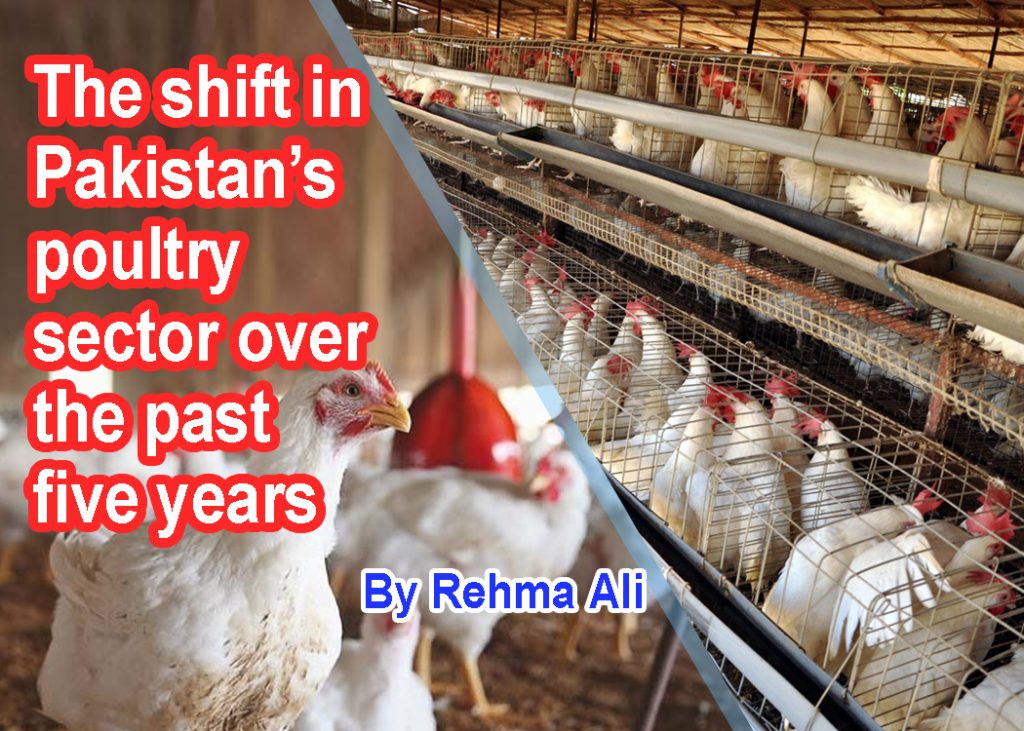
By Rehma Ali
Pakistan’s poultry industry, a cornerstone of the country’s agricultural economy, has undergone significant transformation over the past five years (2019-2024), a period marked by dynamic shifts in production patterns, supply-demand imbalances, and market challenges, all influenced by a mix of domestic factors and global trends.
During the period, Pakistan’s poultry sector has witnessed a considerable growth, solidifying its position as one of the top producers in South Asia, driven by advancements in breeding, nutrition, and management practices.
The sector has diversified, due to broilers, layers (for egg production), and backyard poultry, with the broiler industry making substantial contributions to overall production.
Investments in modern production techniques and high-quality feed, alongside the introduction of improved breeds and better disease management practices, have further boosted the output.
Egg production has also surged, fueled by rising consumer demand for protein-rich food and the adoption of advanced laying systems. However, challenges remain, particularly concerning feed costs and periodic disease outbreaks.
Backyard poultry farming, while smaller in scale compared to commercial operations, continues to play a vital role in the rural economy, providing supplementary income and food security to many households.
The balance of supply and demand in Pakistan’s poultry sector has fluctuated due to several factors.
Rising demand, driven by population growth, urbanization, and evolving dietary preferences, has led to an increase in poultry consumption, with poultry meat and eggs becoming popular for their affordability and nutritional value compared to other meat sources.
Despite this growth in demand, the industry has encountered supply chain challenges, such as feed price fluctuations, transportation issues, and occasional avian disease outbreaks, which have impacted supply stability.
The Covid-19 pandemic further exposed vulnerabilities in the supply chain, leading to temporary shortages and price volatility. Poultry prices have been particularly volatile, influenced by unpredictable feed costs, changes in production levels, and external factors like international trade policies.
Feed costs, which represent a significant portion of production expenses, have been especially erratic, affecting both profitability and pricing. Government policies have also played a crucial role in shaping the poultry sector, with supportive measures like feed subsidies and disease control initiatives being implemented to stabilize the market. However, inconsistent policy implementation and regulatory challenges have at times hindered producers.
Looking ahead, Pakistan’s poultry sector faces a mix of opportunities and challenges.
Technological advancements, driven by continued investment in technology and research, are expected to enhance productivity and efficiency within the industry. Innovations in areas such as breeding, feed formulation, and disease management will be crucial for sustaining growth.
At the same time, there is increasing awareness of the environmental impact of poultry farming, making sustainable practices, including waste management and efficient resource use, more important than ever to address environmental concerns and meet consumer expectations.
The sector also has significant export potential, with opportunities to expand into international markets. Efforts to meet international standards and improve product quality could open new avenues for export.
Additionally, effective disease management and biosecurity practices will be essential to prevent outbreaks that could disrupt production and undermine consumer confidence.
Pakistan’s poultry industry has shown resilience and adaptability over the past five years. Amid persisting challenges, the sector’s growth trajectory and evolving dynamics suggest a promising future with significant potential for further development and expansion. However, Success will depend on addressing supply chain issues, embracing technological advancements, and adapting to changing market conditions.





